
FACULTY OF ENGINEERING
Department of Aerospace Engineering
GEAR 303 | Course Introduction and Application Information
| Course Name |
Clothes in the Movies
|
|
Code
|
Semester
|
Theory
(hour/week) |
Application/Lab
(hour/week) |
Local Credits
|
ECTS
|
|
GEAR 303
|
Fall/Spring
|
2
|
2
|
3
|
4
|
| Prerequisites |
None
|
|||||
| Course Language |
English
|
|||||
| Course Type |
Service Course
|
|||||
| Course Level |
First Cycle
|
|||||
| Mode of Delivery | - | |||||
| Teaching Methods and Techniques of the Course | - | |||||
| Course Coordinator | ||||||
| Course Lecturer(s) | ||||||
| Assistant(s) | - | |||||
| Course Objectives | The aim of this course is to enable students to comprehend the relationship between fashion and cinema by means of films and readings and to acquire the necessary skills for analysis at academic level. |
| Learning Outcomes |
The students who succeeded in this course;
|
| Course Description | This course will provide an advanced level of knowledge in the cultural and artistic context of fashion. This course will consist of 3 thematically divided sections: a. films about the fashion industry; b. Films, clothing and identity, c. Films, clothing and storytelling. |
|
|
Core Courses | |
| Major Area Courses | ||
| Supportive Courses | ||
| Media and Management Skills Courses | ||
| Transferable Skill Courses |
WEEKLY SUBJECTS AND RELATED PREPARATION STUDIES
| Week | Subjects | Related Preparation |
| 1 | Introduction | |
| 2 | Costume and Character: The Great Gatsby | Reading: http://clothesonfilm.com/costume-in-the-great-gatsby-use-your-imagination/ http://clothesonfilm.com/martinprada-great-gatsby-collaboration-fashion-as-costume/ |
| 3 | Lecture on Costume and character and explanation of assignment | |
| 4 | Costume and Character: Elizabeth: The Golden Age, Shekhar Kapur,2007 | Chapter 4, Laver, James, A Concise History of Fashion, Thames and Hudson, 1992 |
| 5 | Costume and Gender: Orlando, Sally Potter,1992 | Chapter 4, Laver, James, A Concise History of Fashion, Thames and Hudson, 1992 |
| 6 | Costume and Gender: The Iron Lady, Phyllida Lloyd 2011 | https://clothesonfilm.com/the-iron-lady-co stume-as-distinction-gender-and-protecti on/ |
| 7 | Costume and Time: Marie Antoinette Sophia Coppola 2006 | http://costumevault.blogspot.com/2016/02/marie-antoinette-working-with.html http://costumevault.blogspot.com/2015/11/marie-antoinette-telling-story-through.html |
| 8 | Costume and Time: The Grand Budapest Hotel, Wes Anderson,2014 | https://clothesonfilm.com/the-wes-anderson-collection-the-grand-budapest-hotel/ |
| 9 | Costume and Time: Phantom Thread | Chapter 10: Laver, James, History of Fashion, Thames and Hudson, 1992,p.252-292. |
| 10 | Lecture on Subcultures and Style | |
| 11 | Costume and Subcultures: Funny Face | Chapter 10: Laver, James, History of Fashion, Thames and Hudson, 1992,p.252-292. |
| 12 | MIDTERM EXAM | All movies and literature mentioned above, plus class discussions |
| 13 | PRESENTATIONS | Group work |
| 14 | PRESENTATIONS | Group work |
| 15 | Semester Review | |
| 16 | Final project |
| Course Notes/Textbooks | Stella Bruzzi, Undressing cinema. Clothing and identity in the movies, London 1997. Laver, James, A Concise History of Fashion, Thames and Hudson, 1992, ISBN:0-500-20348-2 Blog: www.clothesonfilm.com |
| Suggested Readings/Materials | Blog: www.clothesonfilm.com |
EVALUATION SYSTEM
| Semester Activities | Number | Weigthing |
| Participation | ||
| Laboratory / Application | ||
| Field Work | ||
| Quizzes / Studio Critiques | ||
| Portfolio | ||
| Homework / Assignments |
1
|
30
|
| Presentation / Jury | ||
| Project |
1
|
30
|
| Seminar / Workshop | ||
| Oral Exams | ||
| Midterm |
1
|
40
|
| Final Exam | ||
| Total |
| Weighting of Semester Activities on the Final Grade |
4
|
100
|
| Weighting of End-of-Semester Activities on the Final Grade | ||
| Total |
ECTS / WORKLOAD TABLE
| Semester Activities | Number | Duration (Hours) | Workload |
|---|---|---|---|
| Theoretical Course Hours (Including exam week: 16 x total hours) |
16
|
2
|
32
|
| Laboratory / Application Hours (Including exam week: '.16.' x total hours) |
16
|
2
|
32
|
| Study Hours Out of Class |
10
|
2
|
20
|
| Field Work |
0
|
||
| Quizzes / Studio Critiques |
0
|
||
| Portfolio |
0
|
||
| Homework / Assignments |
1
|
10
|
10
|
| Presentation / Jury |
0
|
||
| Project |
1
|
8
|
8
|
| Seminar / Workshop |
0
|
||
| Oral Exam |
0
|
||
| Midterms |
1
|
20
|
20
|
| Final Exam |
0
|
||
| Total |
122
|
COURSE LEARNING OUTCOMES AND PROGRAM QUALIFICATIONS RELATIONSHIP
|
#
|
Program Competencies/Outcomes |
* Contribution Level
|
||||
|
1
|
2
|
3
|
4
|
5
|
||
| 1 | To have theoretical and practical knowledge that have been acquired in the area of Mathematics, Natural Sciences, and Aerospace Engineering. |
|||||
| 2 | To be able to assess, analyze and solve problems by using the scientific methods in the area of Aerospace Engineering. |
|||||
| 3 | To be able to design a complex system, process or product under realistic limitations and requirements by using modern design techniques. |
|||||
| 4 | To be able to develop, select and use novel tools and techniques required in the area of Aerospace Engineering. |
|||||
| 5 | To be able to design and conduct experiments, gather data, analyze and interpret results. |
|||||
| 6 | To be able to develop communication skills, ad working ability in multidisciplinary teams. |
|||||
| 7 | To be able to communicate effectively in verbal and written Turkish; writing and understanding reports, preparing design and production reports, making effective presentations, giving and receiving clear and understandable instructions. |
|||||
| 8 | To have knowledge about global and social impact of engineering practices on health, environment, and safety; to have knowledge about contemporary issues as they pertain to engineering; to be aware of the legal ramifications of Aerospace Engineering solutions. |
|||||
| 9 | To be aware of professional and ethical responsibility; to have knowledge about standards utilized in engineering applications. |
|||||
| 10 | To have knowledge about industrial practices such as project management, risk management, and change management; to have awareness of entrepreneurship and innovation; to have knowledge about sustainable development. |
|||||
| 11 | To be able to collect data in the area of Aerospace Engineering, and to be able to communicate with colleagues in a foreign language (‘‘European Language Portfolio Global Scale’’, Level B1). |
|||||
| 12 | To be able to speak a second foreign language at a medium level of fluency efficiently. |
|||||
| 13 | To recognize the need for lifelong learning; to be able to access information, to be able to stay current with developments in science and technology; to be able to relate the knowledge accumulated throughout the human history to Aerospace Engineering. |
|||||
*1 Lowest, 2 Low, 3 Average, 4 High, 5 Highest
NEWS |ALL NEWS
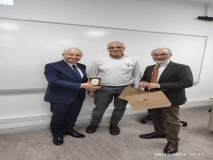
Prof. Pasquale's visit
Prof. Pasquale Daponte from the University of Benevento Sannio, Italy visited our Aerospace Engineering department during the period from 07.03 to 10.03 to discuss
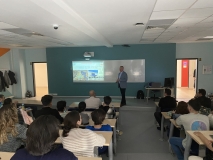
Presentation of Prof. Slawomir Szrama
Prof. Slawomir Szrama visited our university and Aerospace Engineering department during period from 04.03.2024 to 08.03.2024. He gave a talk about "Neural Networks
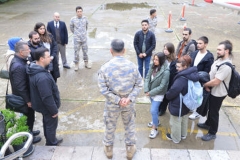
Technical Trip of The Aerospace Engineering Department to Gaziemir
A technical trip was conducted to the Aviation Sciences laboratories of the Air Force Non-Commissioned Officer Vocational School affiliated with the National
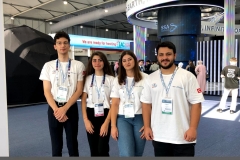
Award-winning helicopters promoted in Azerbaijan
Izmir University of Economics (IUE) students, who managed to receive awards at TEKNOFEST two years in a row with the cargo transport
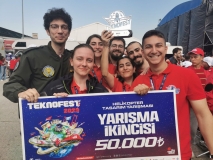
ECO-Dynamics places second in Teknofest Helicopter Design Competition with their attack helicopter
The "ECO-Dynamics" team, consisting of 7 students, Pınar Akın, Eda Nur Tetik, Kutlu Akar, Melisa Gündoğdu, Mehmet Ali Tekin, Tuna Deniz ve
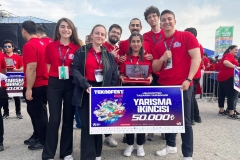
They came second with the helicopter design
The ‘ECO-Dynamics’ team, consisting of 7 students from Izmir University of Economics (IUE) Department of Aerospace Engineering,

Visitor from NASA
Jay Trimble, Mission System Manager at NASA Ames Research Center, met with students at the two-day conference on NASA's Space Travel, organized


